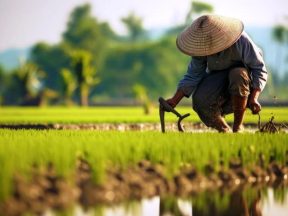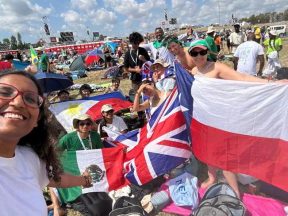Ethiopia. The Gumuz. A marginalized People.
We have travelled for 500 kms in northwest Addis Ababa. First, it was along the road which joins the capital with Bahr Dar, up to Injibara (or Koso Berr). Then, in Injibara we turned straight west in
the direction of Sudan.
After leaving Chagni behind, the last town of the Amhara Region on that road, there is a mountain pass and the road abruptly descends into a plain roasted by the sun. A group of women are walking along the dusty road. They carry a pole, roughly one metre in length, across their shoulders. Tangled ropes hang down at either end, each supporting a load: a large plastic water jerry can, containers one on top of another according to size, filled with grain, bundles of firewood, etc. Given that the jarry cans hold 25 litres of water, you can quickly calculate that the weight each woman is carrying on her back could easily be 40 or 50 kilos. Their bodies are short and stocky and their skin is black,
very black, in contrast with the other people we have met so far
on our journey.
It becomes immediately evident that we have just crossed not merely a mountain pass but also a human frontier. The people we have met are the Gumuz and this is their land. In contrast to the highlanders who are either of Semitic (Tigreans, Amharas) or Hamitic stock (Oromos, Agaws Sidamas), the Gumuz are catalogued as Nilo-Saharians, consequently, more related with Sudanese people than with the Etiopians. In the present administrative division, which goes back to 1991, they are found in the Regional State of Benishangul-Gumuz, which stretches north and south of the Blue Nile, near the border with Sudan. It covers 77,269 square kilometres and the capital of the region is Assossa, located south of the Nile. The Gumuz are not the only people living in the region nor are they the largest group, making up only 23%. The most numerous are the Berta (26%), a Nilotic group like the Gumuz. Other groups like the Amhara, the Agaw and the Oromos, though numerous, are considered foreign to the region, so they cannot hold high political positions.
A history of oppression and marginalization.
The Benishangul-Gumuz Regional State is divided into three provinces. The largest of them is Metekel, north of the Nile, in which two thirds of the Gumuz live. The other two, Kamashi and Assossa are south of the Nile and the Gumuz living there seem to have left Metekel and crossed the river little more than a century ago.
Although they still retain many of the gumuz traditions, they have lost others through exposure to the Oromo.
The concept the people from the highlands (Amharas, Oromos, Agaws) have of the Gumuz is deplorable. For them the Gumuz are primitive and savage people who kill each other and who assassinate those who venture into their land.
Until the works of the Nile Grand Renaissance dam started in 2011 and traffic intensified in the area, there were touristic guides or track drivers who categorically refused to go beyond Chagni, the last town of the Amhara region before descending into the land of those whom they derogatorily called ‘blacks’. There can be an appearance of truth in these prejudices. First of all, there is the undeniable physical fact that the Gumuz are very black in comparison with the ‘red’, a word by which the people of the highlands of much lighter skin color and thinner facial features, are known. The relation between the two groups has always been, and still is, conflictual, not excluding episodes of bloodshed. But those on the losing side have been always the Gumuz, not the ‘red’.
In fact, the history of the Gumuz, until recent times, is a history of oppression and marginalization. The lands inhabited by them were the hunting grounds of the high class of the Ethiopian empire. These were lowlands, hot and rich in wild animals. Hunting expeditions of the Amhara or Agaw included also the hunting of slaves. One of the main sources of emperor Menilik’s self-financing were the slaves captured among the Gumuz and other Nilotic tribes along the border with Sudan. When the open slave trade stopped around 1930, the marginalization of the Gumuz and the occupation of their land on the part of the neighboring tribes continued and even intensified. The other tribes progressively invaded their best land, especially on the slopes of the mountains, pushing the Gumuz to the lower and hotter places.
In this process, they counted on the collaboration of the Gumuz themselves, who were ready to rent their land to the ‘reds’, mostly the Agaw, in exchange for money or for a division of the crops. This practice still continues today since the agriculture of the Agaw is much more advanced than that of the Gumuz.
This history of marginalization has undoubtedly marked the character of the Gumuz. The first impression one gets of them is that they are reserved and surly, almost hostile, at least in comparison with other neighbouring peoples. Their smile is not immediate and spontaneous, not even taken for granted. Their greetings are short. If neighbouring peoples have many prejudices against the Gumuz, also they have their prejudices against the ‘reds’ and their stories about them which they tell in an ironic tone, that tone with which the ‘weaker’ take revenge on the stronger. (J.G.N.)







